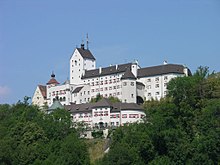Reign of Hohenaschau
The rule Hohenaschau was one with high and blood courts equipped domination in Chiemgau in the Bavarian-Tyrolean border. The seat was Hohenaschau Castle .
history
Most of the area in the upper Priental had been owned by the Salzburg Archbishopric since the 8th century . In the middle of the 12th century, this transferred the administration to the Counts of Falkenstein-Neuburg as bailiffs . These in turn set the Lords of Hirnsberg as subordinates for the area around Aschau, which thus formed a unit with the Wildenwart rule until an inheritance was divided around 1300 . The first part of Hohenaschau Castle was built around 1165 by Konrad and Arnold von Hirnsberg .
Due to economic difficulties and the extinction of male lineages, the rulership changed. The important noble families of the Barons von Preysing (beginning with Johann Christoph von Preysing 1608) and Freyberg (from 1688) expanded the property and made the castle the center of the administrative seat of their rule. In the 16th century, Pankraz von Freyberg managed to buy up many smaller properties in the area and in 1529 to acquire the holdings of the Prince Archdiocese of Salzburg in the Priental. The Hohenaschau rulership was not a principality in the strict sense of the word, but it nevertheless had a number of sovereign rights, such as the right of high and blood jurisdiction, which were derived from belonging to Salzburg and which could be preserved even after the transformation into secular rule.
Starting with the Freybergers, iron processing was promoted in the upper Priental and a forest and alpine regime was issued. The subsequent economic upswing also allowed the castle to be expanded and redesigned, initially in the Renaissance (1540–1560) and High Baroque (1672–1686) styles . In 1704 ( War of the Spanish Succession ) and 1809 ( Tyrolean popular uprising ), the Hohenaschau rulership area was subject to military attacks and the castle was plundered.
In 1771 the nearby Wildenwart rule also came into the possession of the Preysings and was reunited with the Hohenaschau rule. The largest localities were the villages of Prien and Niederaschau , which in 1804 consisted of 33 and 23 houses respectively. In 1813 the lordships of Wildenwart and Hohenaschau were transformed into a royal Bavarian , Counts-Preysingian lordship court based in Prien . The 1818 repeal of the lending was challenged in court, so that the court lasted until the revolution in 1848 . From 1827 the Gräfl. Preysing's lordship courts in Brannenburg and Neubeuert are administered from Prien. From 1848 all noble lords were abolished.
Hohen- and Niederaschau became independent political communities in the course of the administrative reforms in Bavaria in 1818 . On January 1, 1966, Hohen- and Niederaschau were merged to form the municipality of Aschau im Chiemgau.
literature
- Gertrud Diepolder, Richard van Dülmen, Adolf Sandberger: Historical Atlas of Bavaria, Altbayern booklet 38. The district courts Rosenheim and Auerburg and the dominions Hohenaschau and Wildenwart . Munich 1978.
- Margot Hamm: The Hohenaschau rule and the Priental . Aschau 2003 (682 pages).
- Bayerlacher: Brief description of the royal Bavarian regional court in Rosenheim and the Count's Preysingian rulership court Hohenaschau , Munich 1841 (online) .
Individual evidence
- ↑ Joseph Hazzi: Statistical information about the Duchy of Baiern . Volume 3, Part II, Nuremberg 1804, pp. 608 ff .
